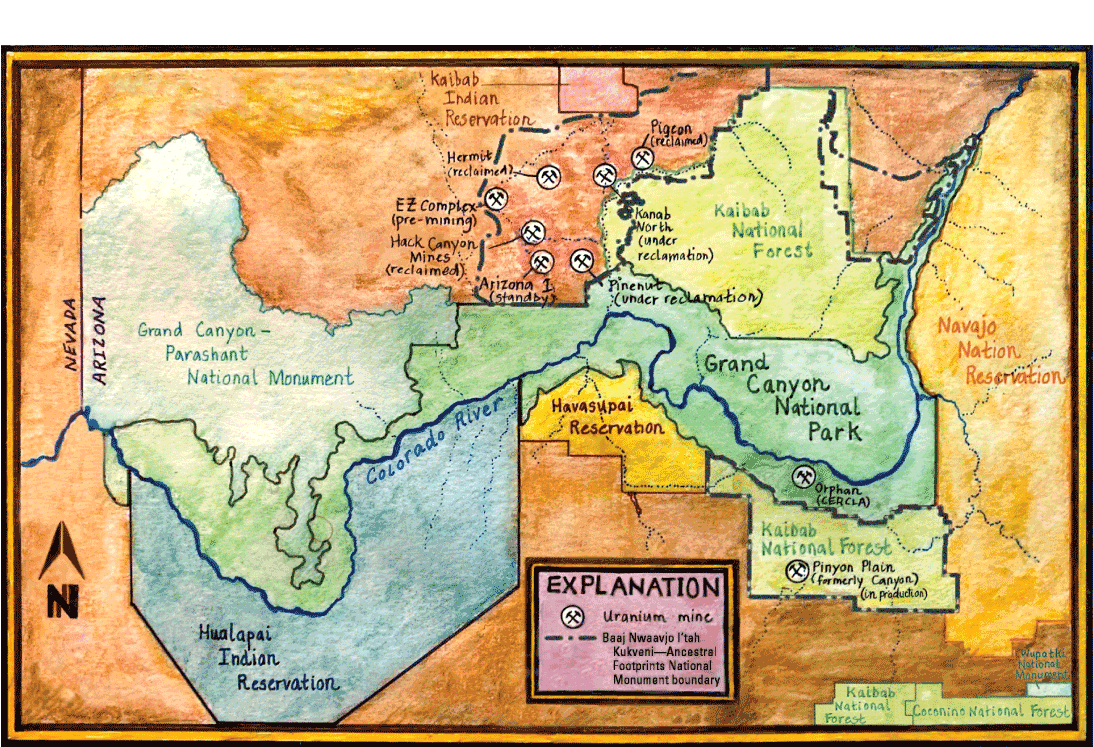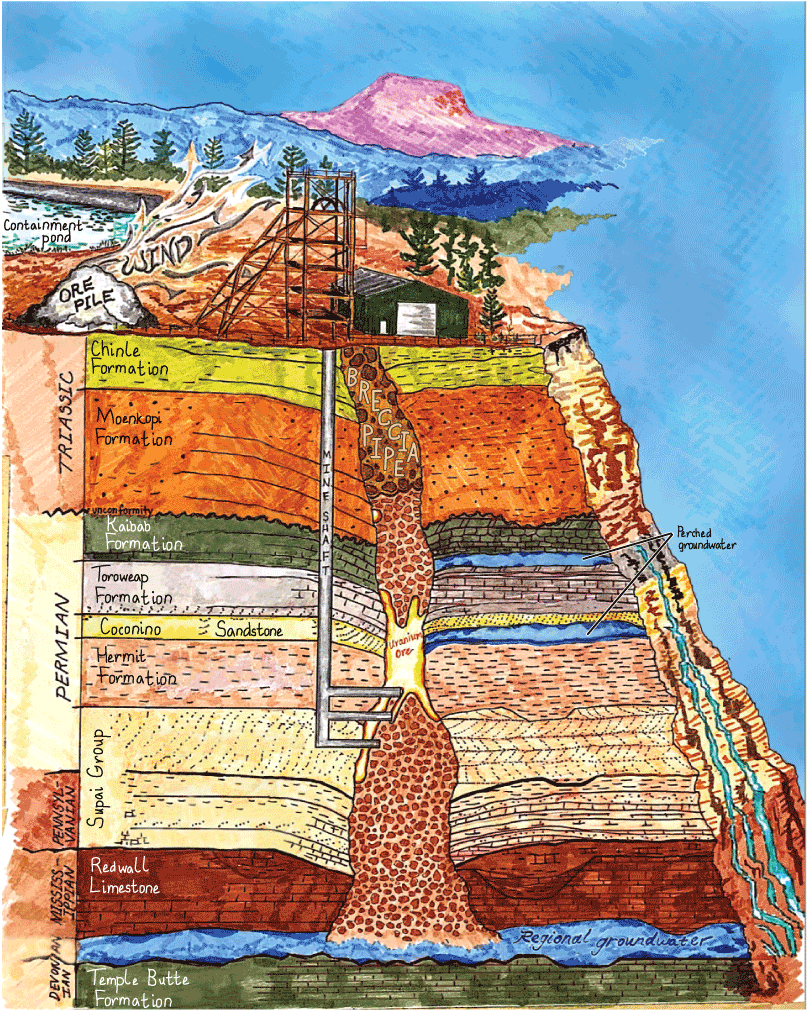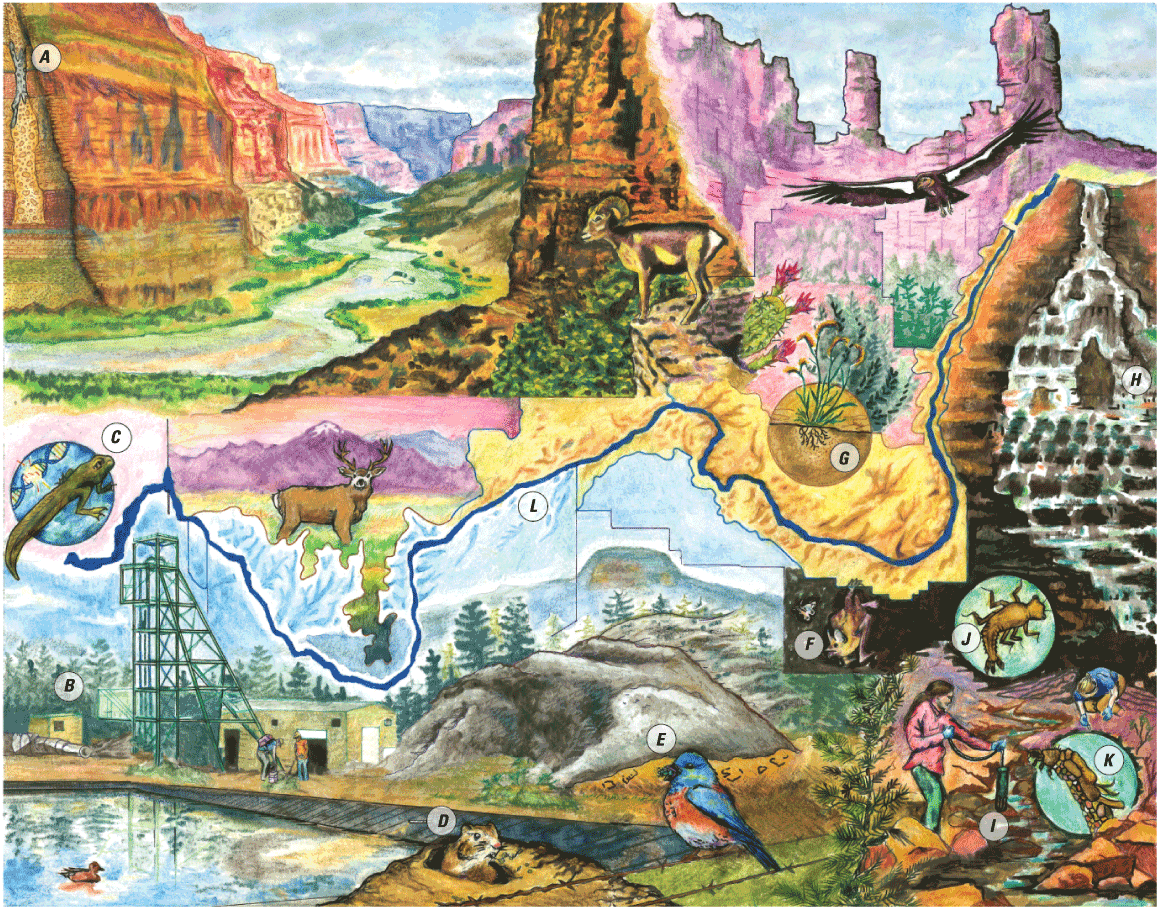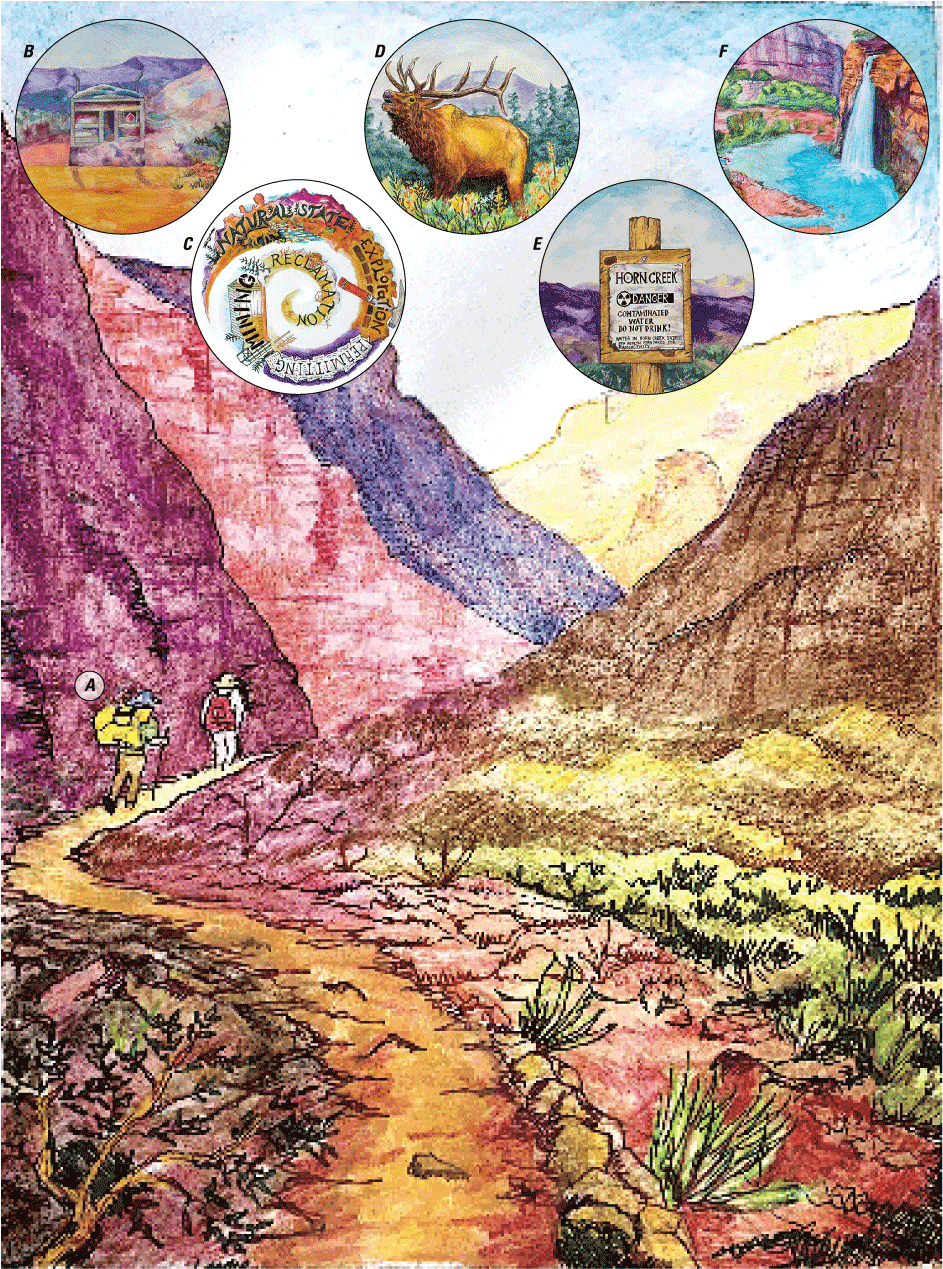Balancing Natural Resource Use and Extraction of Uranium and Other Elements in the Grand Canyon Region
Links
- Document: Report (2.63 MB pdf) , HTML , XML
- Related Works:
- USGS General Information Product 239 - Contaminant exposure framework—Havasupai Perspective
- USGS General Information Product 240 - Conceptual risk framework—Havasupai Perspective
- USGS General Information Product 241 - Havasuw Baj Gwawg Gnavg
- USGS General Information Product 249 - Uranium mining, the Grand Canyon region, and the science of an ecosystem
- USGS Open-File Report 2023-1092 - Expanded conceptual risk framework for uranium mining in Grand Canyon watershed—Inclusion of the Havasupai Tribe perspective
- USGS Scientific Investigations Report 2010-5025 - Hydrological, geological, and biological site characterization of breccia pipe uranium deposits in Northern Arizona
- USGS web page - Informing future decision-making on uranium mining—A coordinated approach to monitor and assess potential environmental impacts from uranium exploration and mining on federal lands in the Grand Canyon region, Arizona, updated March 2014
- Data Releases:
- USGS data release - Breccia pipe uranium mine bird survey data, Grand Canyon region, 2014-2015
- USGS data release - Biogeochemical data of water, sediments, periphyton, and macroinvertebrates collected from springs in and near Grand Canyon National Park, Arizona (ver. 4.0, October 2022)
- USGS data release - Geochemical and X-ray diffraction analyses of drill core samples from the Canyon uranium-copper deposit, a solution-collapse breccia pipe, Grand Canyon area, Coconino County, Arizona
- USGS data release - Vegetation cover and composition data in environments surrounding uranium mines in the Grand Canyon ecosystem, USA
- USGS data release - Geochemical and mineralogical analyses of uranium ores from the Hack II and Pigeon deposits, solution-collapse breccia pipes, Grand Canyon region, Mohave and Coconino Counties, Arizona, USA
- USGS data release - Mineralogical analyses of drill core samples from the Canyon uranium-copper deposit, a solution-collapse breccia pipe, Grand Canyon area, Coconino County, Arizona, USA
- USGS data release - Surface materials data from breccia-pipe uranium mine and reference sites, Arizona, USA
- Download citation as: RIS | Dublin Core
Abstract
The Grand Canyon region is an important natural, cultural, and archeological resource known worldwide. The region contains uranium resources that could be used to generate electricity. The U.S. Geological Survey (USGS), in cooperation with the National Park Service, Bureau of Land Management, and U.S. Department of Agriculture Forest Service, is conducting studies to answer questions about the environmental effects of mining uranium and other associated elements in the region.
Why the Grand Canyon?
The Colorado Plateau, including the Grand Canyon (fig. 1), contains natural sources of uranium and other elements that have been mined for decades. Mining changes the natural landscape and has environmental effects (U.S. Department of the Interior, 2012). The Grand Canyon is of immeasurable importance to local indigenous people who have inhabited the region for thousands of years (National Park Service, 2023). The Grand Canyon is also a World Heritage Site visited in 2023 by almost 5 million people (National Park Service, 2024). This area also includes Baaj Nwaavjo I’tah Kukveni–Ancestral Footprints National Monument that was established in 2023 (fig. 1; Biden, 2023).

Illustration of the Grand Canyon region in northwestern Arizona showing major land holders and locations of some of the uranium mines in the region. Mine status and Tribal land names current as of January 2024.
What are breccia pipes?
The Grand Canyon region contains hundreds of unique geologic breccia pipe features (fig. 2). A few of them contain uranium and other elements about 1,000 feet below ground, and some have been mined (Alpine, 2010). Uranium is used to generate electricity. The breccia pipes in the Grand Canyon region contain some of the highest-grade uranium ores in the Nation (Alpine, 2010). As of August 2023, new mining is not allowed within the Baaj Nwaavjo I’tah Kukveni–Ancestral Footprints National Monument. There are a small number of breccia-pipe mines within the national monument that are permitted to continue (Biden, 2023). Breccia pipes with uranium located outside the national monument could also be mined in the future.

Schematic geologic cross section of a breccia pipe uranium deposit showing uranium ore at depth being accessed by underground workings and a head frame at the surface. The ore occurs primarily in the Coconino Sandstone. Also shown are perched groundwater aquifers that support springs in the area and the regional groundwater aquifer at the bottom of the breccia pipe. Modified from Alpine (2010).
What are the effects of uranium mining?
Scientific data support decisions that could balance uses of natural resources (land, water, plants, and animals). The USGS is a Federal agency that provides scientific data to decision makers and the public (U.S. Geological Survey, 2021). In 2012, the USGS was directed by the Department of the Interior to study the effects of uranium mining in the Grand Canyon region (U.S. Department of the Interior, 2012; Hinck and others, 2014b). Studies designed by the USGS and natural resources managers are underway or completed. Study results are available to everyone, and this document summarizes some of the results of these studies.
What have we learned about how mining affects resources that humans use?
Uranium is important, but it is not only about the uranium.
-
• Uranium ore in breccia pipes contains large amounts of many elements including arsenic, cadmium, cobalt, copper, lead, molybdenum, nickel, selenium, silver, sulfur, uranium, and zinc (fig. 3A; Bern and others, 2019; Van Gosen and others, 2020a, b, c).
-
• Mining increases levels of uranium and some of these ore-related elements in soil around the mine sites (fig. 3B; Naftz and Walton-Day, 2016; Walton-Day and others, 2019).
-
• Wind can move dust containing ore-related elements to areas around the mine (fig. 2) (Bern and others, 2019; Hinck and others, 2017).
-
• Uranium ore piles produce greater radon gas levels than the mine vent during active mining. Wind and rain reduce radon accumulation in air around the mine. Radon is known to be hazardous to human health. Outdoor radon risk thresholds for humans are not available (Naftz and others, 2020; Walton-Day and others, 2021).
Exposure to uranium is not always the cause of greatest concern (risk) to animals at breccia-pipe uranium mines. Other ore-related elements are also important.
-
• Traditional and new study tools (fig. 3C) were used to understand how mining activities can affect local food webs. Elements can enter animals (fig. 3D–F) by ingestion, inhalation, absorption, and dietary transfer (Hinck and others, 2014a, 2017; Klymus and others, 2017; Mann and Duniway, 2020; Albers and others, 2021; Cleveland and others, 2021; Valdez and others, 2021).
-
• Health risks from elements found in uranium ore were low for terrestrial animals studied (fig. 3D). Arsenic, cadmium, copper, and zinc cause the greatest risk to animals that eat ants and other terrestrial invertebrates at breccia-pipe mine sites. Health risks to aquatic animals are unknown (Hinck and others, 2021).
Adverse effects to plants and terrestrial animals from uranium ore-related elements are unlikely even with long-term (30 year) exposure at breccia-pipe uranium mines in the Grand Canyon region.
-
• Radiation levels in plants and animals were low (fig. 3D, G). Radiation enters rodents through soil interactions (for example, burrowing, incidental ingestion, and bathing) or their diet. Amounts of radium-226 were below harmful levels. This radioactive element (radionuclide) is of most concern for rodent health (Hinck and others, 2017; Cleveland and others, 2019; Minter and others, 2019).
-
• Plants and animals (fig. 3D, G) take up mining-related radionuclides, uranium, and other elements, but direct effects such as death and reduced growth were not found (Hinck and others, 2017; Cleveland and others, 2019, 2021). Amounts of arsenic and selenium in water at mine sites may be harmful to aquatic animals like tadpoles (Hinck and others, 2017) (fig. 3C).
Mines are not the only source of uranium in water.
-
• Natural sources of uranium are in groundwater and springs fed by groundwater (fig. 3H, I; Beisner and others, 2017a, b, 2020; Tillman and others, 2021). Uranium is associated with bicarbonate in some Grand Canyon spring water (fig. 3H, I). This form of uranium is not generally taken up by invertebrates living in water (fig. 3J, K; Croteau and others, 2016).
-
• Amounts of uranium and other ore-related elements in Colorado River water in the Grand Canyon region are low (fig. 3L). Sometimes amounts are higher in tributaries where mining has or could occur. These tributaries usually contribute very small amounts of uranium and other ore-related elements to the Colorado River (Tillman and others, 2020).
-
• Groundwater age helps us understand why contaminants might be in groundwater. Old groundwater is mostly cut off from human activities and contamination at the Earth’s surface. Deep groundwater feeding most of the springs on the Grand Canyon southern rim (fig. 3H) is mostly old. Some of the springs contain a portion of relatively young water. Young groundwater is more easily contaminated by human activities, because it has recently had contact with the Earth’s surface (U.S. Geological Survey, 2019; Solder and Beisner, 2020; Solder and others, 2020).
Aquatic insects are unlikely to transport uranium to terrestrial environments.
-
• Aquatic invertebrates (fig. 3J, K), including insect larvae such as mayflies, take up little uranium (Fuller and others, 2019), partly because they generally do not take in the forms of uranium present in the water where they live. Uranium also is in food eaten by invertebrates. Only a limited amount stays in their bodies with most passing through (Croteau and others, 2016; Henry and others, 2020).
-
• Uranium that does end up in mayfly tissues is rapidly removed, which reduces the amount of uranium in their bodies (Henry and others, 2020).

Illustration of U.S. Geological Survey science at breccia pipe mines in the Grand Canyon region. A, The upper left portion shows a cross section of a breccia pipe and rock layers (far upper left) in a panoramic view of the Grand Canyon with upper right depicting rock pinnacles the Havasupai Tribe call Wi’i Gileeva (Tilousi and Hinck, 2024). B, A typical breccia pipe uranium mine site where soil is sampled. C–G, Local plant and animal species studied. H, A spring area with I, scientists measuring water quality and J and K, collecting aquatic invertebrates. L, The Colorado River bisects the illustration.
What questions remain?
Many questions have been answered related to the environmental effects of uranium mining in the Grand Canyon region (fig. 4A), but other questions remain unanswered. Questions such as how does dust (fig. 4B) move uranium and other elements off mine sites throughout the mine life cycle (fig. 4C), what are the effects of uranium and other elements on animals not yet studied (fig. 4D), what is the source of uranium found in springs (fig. 4E) and groundwater (fig. 4F), and what exposures occur during cultural use of resources (fig. 4D, F)? The USGS continues studies with partners to answer these questions. Study results could be used by natural resource managers to guide decisions about mining activities on Federal lands. For more information and updates, visit https://webapps.usgs.gov/uraniummine/.

Drawings illustrating aspects of uranium mining that are not well understood on a background of A, hikers ascending the southern rim of the Grand Canyon; B, road dust created by ore truck transporting uranium ore to processing facilities; C, stages in the mine life cycle from the natural state to reclamation; D, North American elk, a species traditionally hunted by local Tribes in the Grand Canyon region; E, sign in Grand Canyon National Park warning hikers not to drink the uranium-contaminated water in Horn Creek; and F, Havasu Falls whose source is groundwater-fed springs.
References Cited
Albers, J.L., Wildhaber, M.L., Green, N.S., Hinck, J.E., Gatlin, B., and Langston, S., 2021, Breccia pipe uranium mine bird survey data, Grand Canyon region, 2014–2015: U.S. Geological Survey data release, accessed May 2, 2023, at https://doi.org/10.5066/F75D8R5P.
Alpine, A.E., ed., 2010, Hydrological, geological, and biological site characterization of breccia pipe uranium deposits in northern Arizona: U.S. Geological Survey Scientific Investigations Report 2010–5025, 354 p., 1 pl., scale 1:375,000, accessed January 2, 2024, at https://doi.org/10.3133/sir20105025.
Beisner, K.R., Paretti, N.V., Tillman, F.D., Naftz, D.L., Bills, D.J., Walton-Day, K., and Gallegos, T.J., 2017a, Geochemistry and hydrology of perched groundwater springs—Assessing elevated uranium concentrations at Pigeon Spring relative to nearby Pigeon Mine, Arizona (USA): Hydrogeology Journal, v. 25, no. 2, p. 539–556, accessed October 3, 2023, at https://doi.org/10.1007/s10040-016-1494-8.
Beisner, K.R., Solder, J.E., Tillman, F.D., Anderson, J.R., and Antweiler, R.C., 2020, Geochemical characterization of groundwater evolution south of Grand Canyon, Arizona (USA): Hydrogeology Journal, v. 28, no. 5, p. 1615–1633, accessed February 12, 2023, at https://doi.org/10.1007/s10040-020-02192-0.
Beisner, K.R., Tillman, F.D., Anderson, J.R., Antweiler, R.C., and Bills, D.J., 2017b, Geochemical characterization of groundwater discharging from springs north of the Grand Canyon, Arizona, 2009–2016: U.S. Geological Survey Scientific Investigations Report 2017–5068, 58 p., accessed May 3, 2023, at https://doi.org/10.3133/sir20175068.
Bern, C.R., Walton-Day, K., and Naftz, D.L., 2019, Improved enrichment factor calculations through principal component analysis—Examples from soils near breccia pipe uranium mines, Arizona, USA: Environmental Pollution, v. 248, p. 90–100, accessed March 3, 2023, https://doi.org/10.1016/j.envpol.2019.01.122.
Biden, J.R., 2023, Establishment of the Baaj Nwaavjo I’tah Kukveni–Ancestral footprints of the Grand Canyon National Monument: Federal Register, v. 88, no. 156, p. 55331–55344, accessed January 3, 2024, at https://www.govinfo.gov/content/pkg/FR-2023-08-15/pdf/2023-17628.pdf.
Cleveland, D., Hinck, J.E., and Lankton, J.S., 2019, Assessment of chronic low-dose elemental and radiological exposures of biota at the Kanab North uranium mine site in the Grand Canyon watershed: Integrated Environmental Assessment and Management, v. 15, no. 1, p. 112–125, accessed May 2, 2023, at https://doi.org/10.1002/ieam.4095.
Cleveland, D., Hinck, J.E., and Lankton, J.S., 2021, Elemental and radionuclide exposures and uptakes by small rodents, invertebrates, and vegetation at active and post-production uranium mines in the Grand Canyon watershed: Chemosphere, v. 263, p. 127908, accessed June 16, 2023, at https://doi.org/10.1016/j.chemosphere.2020.127908.
Croteau, M.N., Fuller, C.C., Cain, D.J., Campbell, K.M., and Aiken, G., 2016, Biogeochemical controls of uranium bioavailability from the dissolved phase in natural freshwaters: Environmental Science & Technology, v. 50, no. 15, p. 8120–8127, accessed April 15, 2023, at https://doi.org/10.1021/acs.est.6b02406.
Fuller, C.C., Cain, D.J., Croteau, M.N., Barasch, D.A., Beisner, K.R., Stoliker, D.L., Schenk, E.R., and Campbell-Hay, K.M., 2019, Biogeochemical data of water, sediments, periphyton, and macroinvertebrates collected from springs in and near Grand Canyon National Park, Arizona (ver. 3.0, July 2021): U.S. Geological Survey data release, accessed June 2, 2023, at https://doi.org/10.5066/P9CR6GCW.
Henry, B.L., Croteau, M.N., Walters, D.M., Miller, J.L., Cain, D.J., and Fuller, C.C., 2020, Uranium bioaccumulation dynamics in the mayfly Neocloeon triangulifer and application to site-specific prediction: Environmental Science & Technology, v. 54, no. 18, p. 11313–11321, accessed September 17, 2023, at https://doi.org/10.1021/acs.est.0c03372.
Hinck, J.E., Cleveland, D., Brumbaugh, W.G., Linder, G., and Lankton, J., 2017, Pre-mining trace element and radiation exposure to biota from a breccia pipe uranium mine in the Grand Canyon (Arizona, USA) watershed: Environmental Monitoring Assessment, v. 189, article 56, 23 p., accessed September 23, 2023, at https://doi.org/10.1007/s10661-017-5765-1.
Hinck, J.E., Cleveland, D., and Sample, B.E., 2021, Terrestrial ecological risk analysis via dietary exposure at uranium mine sites in the Grand Canyon watershed (Arizona, USA): Chemosphere, v. 265, article 129049, 10 p., accessed June 23, 2023, at https://doi.org/10.1016/j.chemosphere.2020.129049.
Hinck, J.E., Linder, G., Darrah, A.J., Drost, C.A., Duniway, M.C., Johnson, M.J., Méndez-Harclerode, F.M., Nowak, E.M., Valdez, E.W., van Riper, C., III, and Wolff, S., 2014a, Exposure pathways and biological receptors—Baseline data for the Canyon Uranium Mine, Coconino County, Arizona: Journal of Fish and Wildlife Management, v. 5, no. 2, p. 422–440, accessed March 23, 2023, at https://doi.org/10.3996/052014-JFWM-039.
Hinck, J.E., Tillman, F., Van Gosen, B.S., and Walton-Day, K., 2014b, Informing future decision-making on uranium mining—A coordinated approach to monitor and assess potential environmental impacts from uranium exploration and mining on federal lands in the Grand Canyon region, Arizona: U.S. Geological Survey web page, accessed January 23, 2024, at https://webapps.usgs.gov/uraniummine/documents/GrandCanyonSciencePlan.pdf.
Klymus, K.E., Richter, C.A., Thompson, N., and Hinck, J.E., 2017, Metabarcoding of environmental DNA samples to explore the use of uranium mine containment ponds as a water source for wildlife: Diversity, v. 9, no. 4, article 54, 18 p., accessed December 4, 2023, at https://doi.org/10.3390/d9040054.
Mann, R.K., and Duniway, M.C., 2020, Vegetation cover and composition data in environments surrounding uranium mines in the Grand Canyon ecosystem, USA: U.S. Geological Survey data release, accessed June 23, 2023, at https://doi.org/10.5066/P912U706.
Minter, K.M., Jannik, G.T., Hinck, J.E., Cleveland, D., Kubilius, W.P., and Kuhne, W.W., 2019, Biota dose assessment of small rodents sampled near breccia pipe uranium mines in the Grand Canyon watershed: Health Physics, v. 117, no. 1, p. 20–27, accessed June 23, 2023, https://doi.org/10.1097/HP.0000000000001041.
Naftz, D.L., and Walton-Day, K., 2016, Establishing a pre-mining geochemical baseline at a uranium mine near Grand Canyon National Park, USA: Geoderma Regional, v. 7, no. 1, p. 76–92, accessed May 2, 2023, https://doi.org/10.1016/j.geodrs.2016.01.004.
Naftz, D.L., Walton-Day, K., Gardner, W.P., Duniway, M.C., and Bills, D.C., 2020, Natural and anthropogenic processes affecting radon releases during mining and early stage reclamation activities, Pinenut uranium mine, Arizona, USA: Journal of Environmental Radiation, accessed September 3, 2023, at https://doi.org/10.1016/j.jenvrad.2020.106266.
National Park Service, 2023, Associated Tribes: National Park Service, Grand Canyon National Park web page, accessed February 10, 2023, at https://www.nps.gov/grca/learn/historyculture/associated-tribes.htm.
National Park Service, 2024, Grand Canyon National Park, Arizona, park statistics: National Park Service, Grand Canyon National Park web page, accessed April 12, 2024, at https://www.nps.gov/grca/learn/management/statistics.htm#onthisPage-6.
Solder, J.E., and Beisner, K.R., 2020, Critical evaluation of stable isotope mixing end-members for estimating groundwater recharge sources—Case study from the south rim of the Grand Canyon, Arizona: USA: Hydrogeology Journal, v. 28, no. 5, p. 1575–1591, https://doi.org/10.1007/s10040-020-02194-y.
Solder, J.E., Beisner, K.R., Anderson, J.R., and Bills, D.J., 2020, Rethinking groundwater flow on the South Rim of the Grand Canyon, USA—Characterizing recharge sources and flow paths with environmental tracers: Hydrogeology Journal, v. 28, no. 5, p. 1593–1613, accessed December 8, 2022, https://doi.org/10.1007/s10040-020-02193-z.
Tillman, F.D, Anderson, J.R., Unema, J.A., and Chapin, T.P., 2020, Assessing uranium and select trace elements associated with breccia pipe uranium deposits in the Colorado River and main tributaries in Grand Canyon, USA: PLOS One, v. 15, no. 11, paper e0241502, 32 p., accessed December 8, 2022, at https://doi.org/10.1371/journal.pone.0241502
Tillman, F.D., Beisner, K.R., Anderson, J.R., and Unema, J.A., 2021, An assessment of uranium in groundwater in the Grand Canyon region: Scientific Reports, v. 11, article 22157, 15 p., accessed December 4, 2023, at https://doi.org/10.1038/s41598-021-01621-8.
Tilousi, C., and Hinck, J.E., 2024, Expanded conceptual risk framework for uranium mining in Grand Canyon watershed—Inclusion of the Havasupai Tribe perspective: U.S. Geological Survey Open-File Report 2023–1092, 25 p., accessed January 30, 2024, at https://doi.org/10.3133/ofr20231092.
U.S. Department of the Interior, 2012, Record of decision—Northern Arizona withdrawal; Mohave and Coconino Counties, Arizona: U.S. Department of the Interior, 24 p., accessed December 19, 2023, at https://webapps.usgs.gov/uraniummine/documents/DOI%20%282012%29%20ROD%20Northern%20Arizona%20Withdrawal.pdf.
U.S. Geological Survey, 2019, Groundwater age: U.S. Department of the Interior web page, accessed December 15, 2022, at https://www.usgs.gov/mission-areas/water-resources/science/groundwater-age.
U.S. Geological Survey, 2021, U.S. Geological Survey 21st-century science strategy 2020–2030: U.S. Geological Survey Circular 1476, 20 p., accessed December 8, 2022, at https://doi.org/10.3133/cir1476.
Valdez, E.W., Hanttula, M.K., and Hinck, J.E., 2021, Seasonal activity and diets of bats at uranium mines and adjacent areas near the Grand Canyon: Western North American Naturalist, v. 81, no. 1, p. 1–18, accessed February 10, 2023, at https://doi.org/10.3398/064.081.0101.
Van Gosen, B.S., Benzel, W.M., and Campbell, K.M., 2020a, Geochemical and x-ray diffraction analyses of drill core samples from the Canyon uranium-copper deposit, a solution-collapse breccia pipe, Grand Canyon area, Coconino County, Arizona: U.S. Geological Survey data release, accessed February 10, 2023, at https://doi.org/10.5066/P9UUILQI.
Van Gosen, B.S., Benzel, W.M., Kane, T.J., and Lowers, H.A., 2020b, Geochemical and mineralogical analyses of uranium ores from the Hack II and Pigeon deposits, solution-collapse breccia pipes, Grand Canyon region, Mohave and Coconino Counties, Arizona, USA: U.S. Geological Survey data release, accessed February 10, 2023, at https://doi.org/10.5066/P9VM6GKF.
Van Gosen, B.S., Benzel, W.M., Lowers, H.A., and Campbell, K.M., 2020c, Mineralogical analyses of drill core samples from the Canyon uranium-copper deposit, a solution-collapse breccia pipe, Grand Canyon area, Coconino County, Arizona, USA: U.S. Geological Survey data release, accessed February 10, 2023, at https://doi.org/10.5066/P9F745JX.
Walton-Day, K., Bern, C.R., Naftz, D.L., Gross, T.A., and O’Shea, P.M., 2019, Surface materials data from breccia-pipe uranium mine and reference sites, Arizona, USA: U.S. Geological Survey data release, accessed February 10, 2023, at https://doi.org/10.5066/P9KTLXL8.
Walton-Day, K., Wendel, J.R., Hinck, J.E., Naftz, D.L., and Qi, S.L., 2021, Invisible—Radon gas at the Pinenut uranium mine: U.S. Geological Survey web page, accessed July 30, 2022, at https://apps.usgs.gov/colorado-water/radon-pinenut-mine.html.
Disclaimers
Any use of trade, firm, or product names is for descriptive purposes only and does not imply endorsement by the U.S. Government.
Although this information product, for the most part, is in the public domain, it also may contain copyrighted materials as noted in the text. Permission to reproduce copyrighted items must be secured from the copyright owner.
Suggested Citation
Walton-Day, K., Siebers, B.J., Hinck, J.E., Campbell, K.M., Croteau, M.-N., 2024, Balancing natural resource use and extraction of uranium and other elements in the Grand Canyon region: U.S. Geological Survey Fact Sheet 2024–3003, 6 p., https://doi.org/10.3133/fs20243003.
ISSN: 2327-6932 (online)
ISSN: 2327-6916 (print)
Study Area
| Publication type | Report |
|---|---|
| Publication Subtype | USGS Numbered Series |
| Title | Balancing natural resource use and extraction of uranium and other elements in the Grand Canyon region |
| Series title | Fact Sheet |
| Series number | 2024-3003 |
| DOI | 10.3133/fs20243003 |
| Publication Date | June 03, 2024 |
| Year Published | 2024 |
| Language | English |
| Publisher | U.S. Geological Survey |
| Publisher location | Reston, VA |
| Contributing office(s) | Colorado Water Science Center, Upper Midwest Water Science Center |
| Description | Report: 6 p.; 7 Data Releases |
| Country | United States |
| State | Arizona |
| Other Geospatial | Grand Canyon Region |
| Online Only (Y/N) | N |


